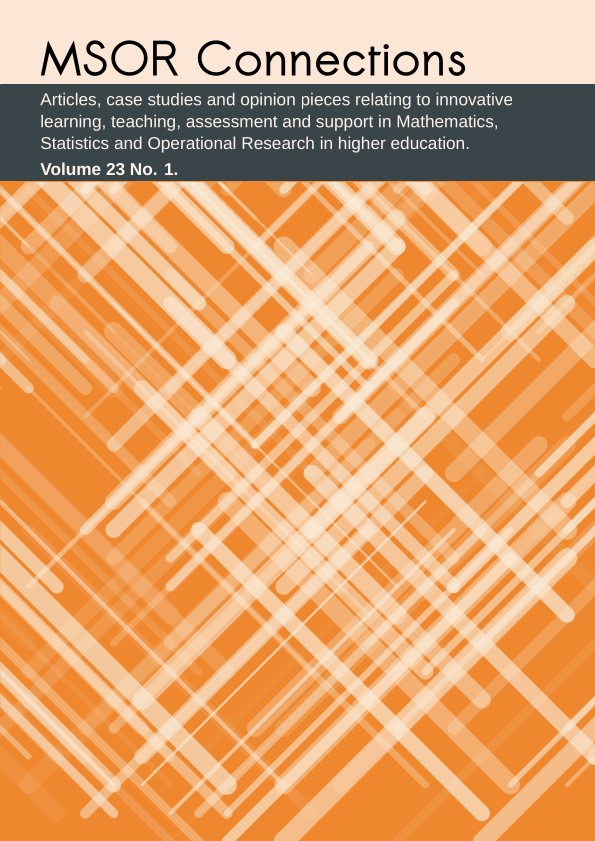A Tool to Visualise and Interact with Probability Density Functions - Development and Case Study
DOI:
https://doi.org/10.21100/msor.v23i1.1504Keywords:
Teaching application, visual learning, statistics, probability density functions, python.Abstract
This article is an overview of the design, implementation and testing of a tool to visualise and interact with probability density functions. The tool is a desktop application implemented entirely in Python using the tkinter library for the graphical user interface. The project was undertaken as part of a collaboration between Mathematics and Computer Science. The goal of the application is to provide a simple user interface for teaching staff and students to visualise and interact with probability density functions. The application should help improve students’ understanding of the concepts involved and its simple design should reduce the complexity barrier that often faces users when using technology in the classroom. Following initial testing, a variety of teaching staff were involved with trialling the tool, together with student volunteers from a first-year and second-year statistics module at Swansea University. Feedback was obtained and evaluated from all participants. For the teaching staff group, we found that all four participants strongly agreed that the application is easy to use and that the user interface was not distracting. Furthermore, all teaching staff stated that they would consider using the application in their own teaching and all would recommend using the application to a colleague/friend. For the student volunteer group, all twelve participants either agreed or strongly agreed with the statements that the application is easy to use, useful and not distracting. Similar to the teaching staff group, all the student participants stated that they would consider using the application in their own learning and all would recommend the application to a friend. A full analysis of the survey results is provided in the Feedback section.
References
Amos, D., 2022. Python gui programming with tkinter. Available at: https://realpython.com/python-gui-tkinter/
Arthur, Y.D., 2022. MATHEMATICS TEACHERS’ ACCEPTANCE OF ICT IN TEACHING AND LEARNING: AN EXTENDED TECHNOLOGY ACCEPTANCE MODEL. Problems of Education in the 21st Century, 80(3), pp.408-425. DOI: https://doi.org/10.33225/pec/22.80.408
Bansilal, S., 2015. Exploring student teachers’ perceptions of the influence of technology in learning and teaching mathematics. South African Journal of Education 35(4). DOI: https://doi.org/10.15700/saje.v35n4a1217
Bhagat, K. K. & Chang, C.-Y., 2015. Incorporating geogebra into geometry learning-a lesson from india. Eurasia Journal of Mathematics, Science and Technology Education 11(1), pp. 77-86. DOI: https://doi.org/10.12973/eurasia.2015.1307a
Boaler, J., Chen, L., Williams, C. & Cordero, M., 2016. Seeing as understanding: The importance of visual mathematics for our brain and learning. Journal of Applied & Computational Mathematics 5(5), pp. 1-6. DOI: https://doi.org/10.4172/2168-9679.1000325
Bognar, M., 2021a. The Normal Distribution Applet. Available at: https://homepage.divms.uiowa.edu/~mbognar/applets/normal.html
Bognar, M., 2021b. Matt Bognar Ph.D Homepage. Available at:
https://homepage.divms.uiowa.edu/~mbognar/
Brihadiswaran, G., 2020. A performance comparison between c, java, and python. Available at: https://medium.com/swlh/a-performance-comparison-between-c-java-and-python-df3890545f6d
Christensson, P., 2009. User interface definition. Available at: https://techterms.com/definition/user interface
Cortesi (2022) Pyinstaller manual. Available at: https://pyinstaller.org/en/stable/
Department for Education, 2013. National curriculum in England: mathematics programmes of study: key stage 3. Available at: https://assets.publishing.service.gov.uk/government/uploads/system/uploads/attachment_data/file/239058/SECONDARY_national_curriculum_-_Mathematics.pdf
Empson, R., 2011. Build and share rich educational content with desmos. Available at: https://techcrunch.com/2011/05/24/build-and-share-rich-educational-content- with-desmos/
Ertmer, P. A., Ottenbreit-Leftwich, A. T., Sadik, O., Sendurur, E. & Sendurur, P., 2012. Teacher beliefs and technology integration practices: A critical relationship. Computers & education 59(2), pp. 423-435. DOI: https://doi.org/10.1016/j.compedu.2012.02.001
Forster PA 2006. Assessing technology-based approaches for teaching and learning mathematics. International Journal of Mathematical Education in Science and Technology, 37(2):145-164. DOI: https://doi.org/10.1080/00207390500285826
Fraij, F. & Al-Mahadeen, B., 2012. The effect of visual and interactive toolson students’ performance in identifying one-to-one functions. Journal of Applied Computer Science & Mathematics 12(6).
Gov, W., 2016. Programme of study for mathematics key stages 2–4. Available at: https://hwb.gov.wales/api/storage/e2aad4fc-faae-4054-a382-242d08ee2021/programme-of-study-for-mathematics.pdf
Jelatu, S., Ardana, I. et al., 2018. Effect of geogebra-aided react strategy on understanding of geometry concepts. International journal of instruction 11(4), pp. 325-336. DOI: https://doi.org/10.12973/iji.2018.11421a
Liburd, K. K. D. & Jen, H.-Y., 2021. Investigating the effectiveness of using a technological approach on students’ achievement in mathematics–case study of a high school in a Caribbean country. Sustainability 13(10), 5586. DOI: https://doi.org/10.3390/su13105586
matplotlib, 2022. Matplotlib: Visualization with python. Available at: https://matplotlib.org
Nielsen, J., 2005. Ten usability heuristics. Available at: https://pdfs.semanticscholar.org/5f03/b251093aee730ab9772db2e1a8a7eb8522cb.pdf.
Niu, X. S., 2018. Visualization technology use in secondary mathematics classroom education. Undergraduate Thesis, School of Information and Library Science, University of North Carolina at Chapel Hill. DOI: https://doi.org/10.17615/vdw7-3b83
Ochkov, V. F. & Bogomolova, E. P., 2015. Teaching mathematics with mathematical software. Journal of Humanistic Mathematics 5(1), 265–285. DOI: https://doi.org/10.5642/jhummath.201501.15
Pyinstaller (2022) Using pyinstaller. Available at: https://pyinstaller.org/en/stable/usage.html - splash-screen-experimental
Scharaldi, K., 2020. What are the benefits of teaching math using technology? Available at: https://www.texthelp.com/resources/blog/what-are-the-benefits-of-using- technology-for-math/
Schwaber, K. & Sutherland, J., 2020. Scrum guide. Available at: https://scrumguides.org/scrum-guide.html
Scipy (2022) Statistical functions. Available at: https://docs.scipy.org/doc/scipy/reference/stats.html
Shneiderman, B., Plaisant, C., Cohen, M. S., Jacobs, S., Elmqvist, N. & Diakopoulos, N., 2016. Designing the user interface: strategies for effective human-computer interaction. Pearson. DOI: https://doi.org/10.1075/idj.17.2.14mar
Thomas, D. A. et al., 1996. Integrated mathematics, science, and technology: An introduction to scientific visualization. Journal of Computers in Mathematics and Science Teaching 15(3), pp. 267-94. DOI: https://doi.org/10.1007/978-1-84628-755-8
Van Garderen, D. & Montague, M., 2003. Visual-spatial representation, mathematical problem solving, and students of varying abilities. Learning Disabilities Research & Practice 18(4), pp. 246-254. DOI: https://doi.org/10.1111/1540-5826.00079
Yilmaz, R. & Argun, Z., 2018. Role of visualization in mathematical abstraction: The case of congruence concept. International Journal of Education in Mathematics, Science and Technology 6(1), pp. 41-57. DOI: https://doi.org/10.18404/ijemst.328337

